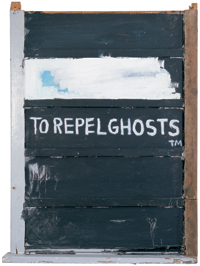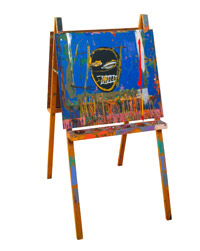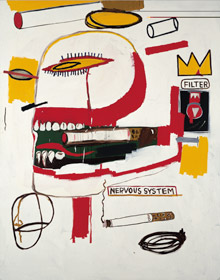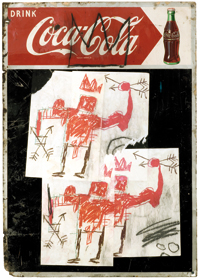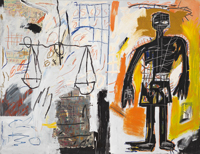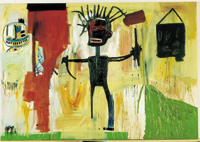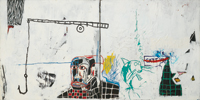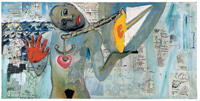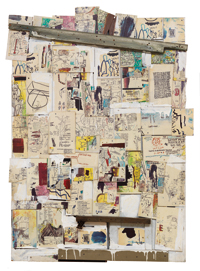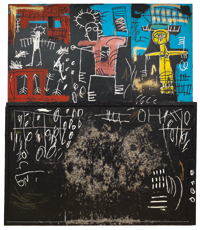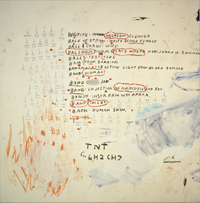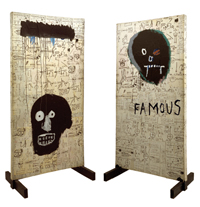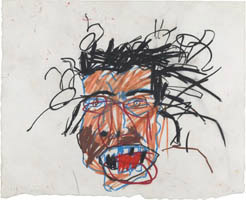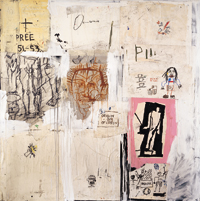Jean Michel Basquiat _ To Repel Ghosts
In collaboration with Fundación Marcelino Botín
Curated by Olivier Berggruen
2 Ottobre 2008 – 1 Febbraio 2010
Catalogue Skira
- Fantasmi da scacciare 1986
- Senza Titolo (Cavalletto) 1983
- Tabacco 1985
- Senza titolo (Coca Cola) 1982
- Senza titolo (Figura nera) 1982
- Autoritratto 1986
- Genio sconosciuto del delta del Mississipi 1982
- Jean Michel Basquiat e Francesco Clemente, 1984
- Natchez 1985
- Senza titolo (Catrame e piume) 1982
- Eroica II 1988
- Famoso 1982
- Autoritratto 1982
- Scarpe Grandi, 1983
Fondazione Memmo and the Marcelino Botín Foundation in Santander are delighted to present an exhibition on Jean-Michel Basquiat, the artist, close to Graffiti art, who triumphed in New York in his early twenties thanks to Andy Warhol.
The exhibition titled “Jean-Michel Basquiat: Banishing Ghosts,” opening at Fondazione Memmo in Palazzo Ruspoli on October 2, 2008, after a summer stop in Santander, will present to the public more than 40 works from Germany, Belgium, France, Italy, Austria, Switzerland, and the United States. Among them, some created in collaboration with Warhol and Francesco Clemente, over ten works presented for the first time to the public, and five unpublished photographs by Michael Halsband.
The exhibition comprises a representative collection of works focused mainly on the fragmented vision that the artist had of the human body. From the late 1970s, when he signed with the acronym SAMO “SAMe Old Shit” (literally the same old shit), until his early death in 1988, Basquiat painted subjects that asserted the precarious nature of urban experience: skeletal bodies, black figures, images rooted in the landscape of his youth (cars, planes, skyscrapers, police, children’s games, cartoons and comics, graffiti, symbol saturation like © or the crown). Soon after, more densely composed works on canvases placed on visible rudimentary frames would follow.
For Basquiat, an accident at the age of seven, followed by a keen study of Gray’s Anatomy, “shaped a vision of the human personality as something fractured and fragmented. This fragmentation also refers to the alienation experienced by a black person in the racist society that would later welcome him as quickly as it would reject him a few years later when drug dependence made him persona non grata among most gallerists and collectors,” as curator Olivier Berggruen explains.
Basquiat’s works feature a spontaneous aggregation of various visual elements, often without correlation, yet clearly declarative and narrative in character. The painting surfaces are fluid, never static but slippery, in a way that reveals Basquiat’s admiration for Cy Twombly (one of the few artists he acknowledged as an influence). The open and deconstructed presentation that the artist gives of reality is characterized by irony and dislocation; some themes reappear regularly, symbols of lost innocence: the crown, black heroes (Hank Aaron, Charlie Parker), cultural models of urban life, essentially black; barred writings and lapidary symbols denote a sense of ambiguity.
The body, constantly evoked, transforms into an idea, a trace of a spectral presence transmitted through the physical energy that characterizes the artist. The image of the “body” initially appears as that of the artist himself, in various guises and anatomical terms. Later, it can be understood as a “scenic body” or “performing body”: the so-called “graffitism.” It is also observed in his interest in images of great musicians and athletes: it’s not just about their “fame”, but the ability to convey something spontaneous, simultaneously sublime.
In Berggruen’s words, the artist strengthens his presence through the evocation of fragments, a way to “banish ghosts,” a favourite phrase that appears in at least three of his paintings. The overwhelming presence of zombie-like creatures seemingly returned from the world of the dead, the remnants of writings, sometimes erased and other times engraved on the canvas with unheard-of force, affirm Basquiat’s particular situation in trying to overcome the abyss between the transience of life and its reaffirmation through the painter’s gesture.
The exhibition will be accompanied by a comprehensive illustrated catalogue, with essays by Olivier Berggruen and Francesco Pellizzi.
The curator of the exhibition, Olivier Berggruen, is the associate curator of the Schirn Kunsthalle in Frankfurt. Among other things, he has organized important exhibitions on Matisse’s collages and Picasso’s theatrical work, as well as retrospectives on Yves Klein and Ed Ruscha.
Biographical Notes:
Jean-Michel Basquiat (New York 1960-1988) grew up in a broken family environment, left school early, and got close to the world of graffiti in 1977, painting on subway cars and in some areas of Soho. His paintings and writings had great poetic, philosophical, and satirical power. The pseudonym SAMO, an acronym for “same old shit”, with which he tagged his graffiti with cryptic messages, was decisive in his life.
Jean-Michel Basquiat’s first exhibition was set up in 1980 in an abandoned warehouse in New York, featuring artworks by punk artists and graffiti artists. The works of the “wild child” were soon appreciated by collectors, but his recognition became even greater when he worked with Andy Warhol in 1983-1984. He died at the age of 27 from a heroin overdose.

